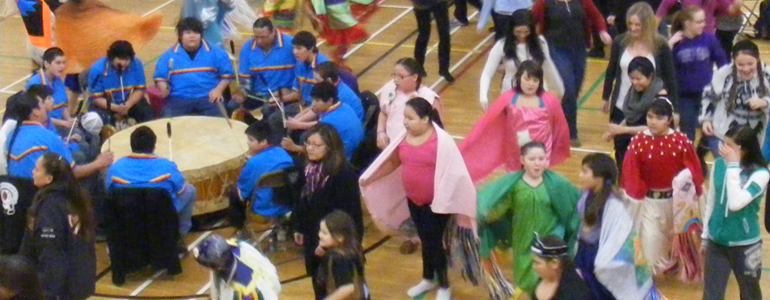Aboriginal Education Day
In a reversal of roles, students taught teachers in one of many Aboriginal Education Day workshops on Friday, February 10. Youth from Antler River Elementary School (located in Chippewas of the Thames First Nation community) used traditional dancing and drumming to promote further learning about Aboriginal education among teacher candidates and other educators in the Faculty of Education.
Aboriginal Education Day began with opening protocols by Elders Dan and Mary Lou Smoke, who welcomed the audience with smudging, singing, and prayers. Each spoke about the meaning and significance of the traditions they shared, interweaving themes of cultural sensitivity and the indigenization of the Western education system. Dr. Christy Bressette, an Anishinaabe band member and the first to complete her doctorate in Aboriginal Studies in the Faculty of Education, used storytelling to overview of the history of the education of Aboriginal peoples in Canada. Through sharing her own survivor stories, Bressette encouraged all teachers to support Aboriginal student success, particularly by demanding student excellence as well as by welcoming Aboriginal cultural knowledge into the classroom.
Participants then attended workshops facilitated by Aboriginal educators, artists, and community members. In “Jiimannike: The Canoe Speaks,” Ojibwe artist Rene Meshake described his Aboriginal worldview through building and using a canoe. As he showed parts of the canoe, Meshake explained, “The canoe is like a person. Like a friend. You develop this friendship even from the time you are hunting for the birch. You start a relationship with you, with the land, with God. Everybody is involved. The canoe is the symbol of science, family, ceremony, math. It’s a way of life. It’s a culture. And,” Meshake smiled, “you have to have fun building this!”
In speaking about the Anishinaabe oral tradition and traditional indigenous values, Doctoral candidate Andrew Judge spoke plainly about the challenges around understanding the complexities of Aboriginal cultures. However, he also emphasized the importance of recognizing the differences amongst First Nations communities. “There’s hundreds of languages on Turtle Island, several of which have many dialects. We do share a circular world view, but it’s important to specify what you are talking about [when teaching students].” Judge also emphasized recognizing the tribes that have lived where teachers teach: “If you don't do anything else [in the classroom], you must honour them and thank them. It’s important to acknowledge that those ancestors were here.”
Kim Wheatley, who is Turtle Clan from Shawanaga First Nation and the Aboriginal Programme Coordinator of Turtle Island Conservation at the Toronto Zoo, showed teacher candidates a range of First Nation-based curriculum resources. Such resources include Turtle Island Conservation’s The Ways of Knowing Guide and Walking With Miskwaadesi and Walking with A’nowara Curriculum Activities, which can be adapted to any level and integrated into other activities, such as celebrating Aboriginal Day (June 21). Wheatley also provided participants with brochures, magnets, and posters, explaining that “Visuals [in the classroom] are important. Aboriginal students need to see themselves. They can be a point of discussion for dialogue.”
For teacher candidate Kiersten Armstrong, Aboriginal Education Day was one of the most memorable PD days of the year. “It’s when you see [Aboriginal knowledge] first-hand, you recognize its value. It’s experiential learning. It’s living what it means.” Armstrong explained that she is committed to indigenizing her classroom, in part through asking for assistance from First Nations communities near her. “They say it takes a village to raise a child,” Armstrong noted, “and I believe that. So I would use the resources that are available to me.”
Indigenizing the Canadian Classroom
Dr. Christine Bressette offered strategies for promoting Aboriginal student engagement and success:
- Make students partners in their learning
- Don’t expect every child to have basic supplies (like the internet)
- Use available resources (such as Bridges Out of Poverty)
- Understand the differences in perspectives (among First Nations, Metis, and Inuit, for example), and actively seek out these different perspectives
- Ask Aboriginal guests to visit your classrooms and share their experiences
- Maintain trust with parents, and solicit their involvement
- Use collaborative rather than competitive activities in the classroom
- Continue to seek out guidance and resources to raise awareness


